 Preparing walls for wallpaper - a rather difficult and complicated process, which depends on how long will you wallpaper In preparing the walls for wallpapering need to also take into account oil and other stains on the walls, which in the future may appear onNew wallpaper. Therefore, it is necessary to provide all the nuances before starting work.
Preparing walls for wallpaper - a rather difficult and complicated process, which depends on how long will you wallpaper In preparing the walls for wallpapering need to also take into account oil and other stains on the walls, which in the future may appear onNew wallpaper. Therefore, it is necessary to provide all the nuances before starting work.
-
- Why do I need to glue wallpaper to the floor laying
- Preparing walls for wallpaper procedure works
- The cover wall before pasting wallpaper
- Why you must first prepare the wall before pasting wallpaper
- What to do with a verycurved walls
- Preparing walls for wallpaper with your own hands( video)
Wallpapering is an occupation that requires some effort and the right approach. Preparing walls for wallpapering is an important point on which the final result depends. In order to do it, you do not need to have special knowledge, it can be done by anyone who does not understand anything in construction matters. You just need to have patience and desire to get an excellent result.
Why you need to glue the wallpaper before laying the floor
When doing repairs, the question arises repeatedly, what should be done first, decorating the floor or wallpaper. For this you need to carefully understand this work.
Things to Consider:
- When laid as flooring laminate, it is likely that during the execution of these works have already sticked wallpapered walls will be accidentally scratched or there will be some contamination. But usually the laying of the floor is done after the wallpaper is pasted, and the dirty and dusty preparatory floor works, such as the screed, are made before the walls are pasted.
- Unlike linoleum and carpet, the laminate is not cut near the junction of the floor and the wall, thus eliminating the possibility of damage to the wallpaper.
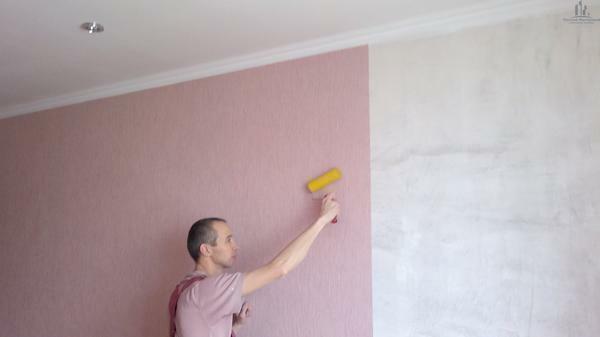 Wallpapers recommend gluing to the floor finish to glue evaporation did not bring any harm to flooring
Wallpapers recommend gluing to the floor finish to glue evaporation did not bring any harm to flooring
But any method has a downside. If we are not sticking wallpaper before laying the floor, and after it, some types of floor covering may be too sensitive to the effects of steam which are released during the drying glue wallpaper without drafts and fresh air.
In other words, the humidity level, which increases during drying due to glutinous evaporation, will be very high. Thus, humidity can greatly affect the state of the pnapol coating.
But if you paste the wallpaper for a long time, and do not every year glue new ones, then there will be practically no negative impact from the adhesive fumes.
Preparing walls for wallpaper: order of work
Before you begin to do wallpapering, you need to prepare the walls. To do everything right, you need to make sure that you have all the necessary materials.
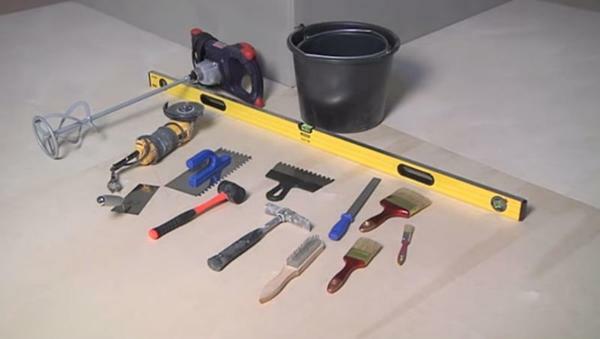 Before starting to work with the walls, you need to prepare the necessary tools
Before starting to work with the walls, you need to prepare the necessary tools
Wall preparation materials and tools:
- Sandpaper;
- Adhesive PVA;
- Fiberglass or gauze;
- Alabaster;
- Putty;
- Primer;
- Two types of spatula;
- Flat container with small flanges;
- Narrow and wide spatula;
- Painter's knife;
- Wide brush or roller;
- Bucket with warm water;
- Painting Scotch tape;
- Film.
First you need to remove the old cover. And then level the walls so that they are perfectly even and dry. If you do not do the pasted wallpaper in a few days will fall away.
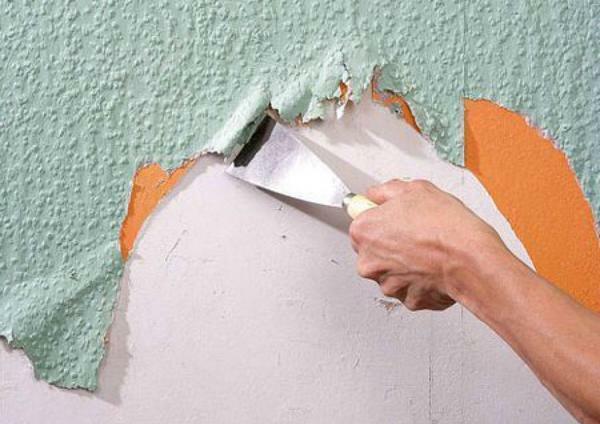 The first stage of preparation of wallpaper walls consists in removing the old
The first stage of preparation of wallpaper walls consists in removing the old
wall preparation procedure for wallpaper wallpapering is conventionally divided into 4 stages:
- In the first stage, if the walls have never been processed, in a new house, a spray of up to 5 millimeters is applied to the walls. With its help, fill all the roughness and roughness of
- The second stage is the priming of the walls. On average, the thickness of its layer should not be more than 5-6 millimeters. If necessary, several primer layers can be applied.
- In the third stage, the final layer of plaster is applied to the wall with a thickness of 2-4 millimeters. This is done in order to create a light, thin film on the ground surface, which is then gently wiped off.
- The final fourth stage involves grinding the walls with sandpaper.
For smooth and dry walls, you can use the gypsum filler purchased at the construction site.
Than to cover the walls before wallpapering
Usually, before wallpapering the wallpaper is smeared with a primer. Previously, when doing repairs, wallpaper glued directly to the walls, not considering it necessary at the same time to cover it with a primer. Thus, they are very tightly adhered.
 glue to retain their properties longer need before pasting the walls with wallpaper to put a uniform layer
glue to retain their properties longer need before pasting the walls with wallpaper to put a uniform layer
primer Today wallpaper started to do a lot heavier and thicker, for this reason, they began to demand more stringent surface preparation.
Because of the soil on the walls, a film is formed, preventing the absorption of moisture into the plaster. In this way the glue retains its properties much longer, and the strength of the wallpaper depends on this.
Before mounting wallpaper using such coatings:
- Universal coverage deep penetration;
- Homemade coating is a well-diluted adhesive for wallpaper;
- Antifungal coating, which is able not only to improve the adhesion of the adhesive to the wall, but also to protect the surface from the appearance of mold and dampness;
- Brick and concrete walls are better covered with perchlorovinyl coating, usually dries about an hour;
- Glyftal coating used to primed metal and wood, dries a few days, it is recommended to use it only for those rooms in which there is a slight moisture;
- An alkyd coating is used to treat walls from wood, dries no more than 15 hours;
- Acrylic coating can be used for processing all kinds of walls, dries for about 5 hours.
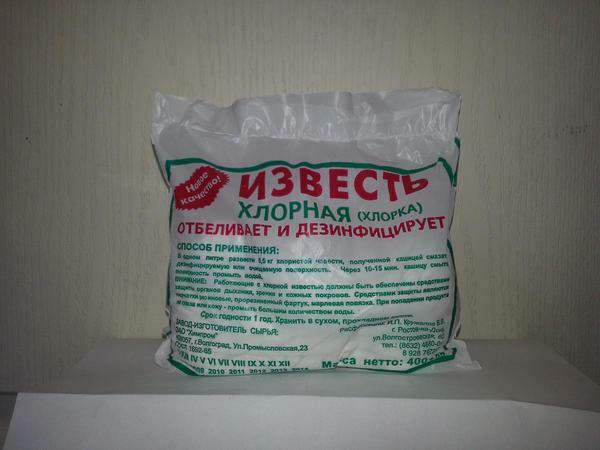 To wallpaper fared the best, recommend to glue them to treat the walls with a solution of bleach
To wallpaper fared the best, recommend to glue them to treat the walls with a solution of bleach
to wallpaper held on tight, before applying the wall can be covered with a solution of bleach. To make it, you need to add 200 g of bleach in 1 liter of water.
Why you must first prepare the wall before pasting wallpaper
There are many reasons for the pre-treatment of the walls to the right wallpapering, to count them all is impossible.
Here are some of them:
- If you want to get the wallpaper, quality sticked, preparing walls simply inevitable. The porous surface of the walls will not be able to hold the wallpaper for a long time. In places with the presence of pores, the base of the wallpaper is simply not able to adhere well.
- Uneven walls must be treated. Even if you choose the thickest and thickest wallpaper coating, irregularities will still be visible.
- Fungus and damp quickly spoil the new glued wallpaper.
- Adhesion is the ability of materials to be combined with substances of a foreign character, so the wallpaper will quickly begin to peel off the walls.
These reasons are enough to not ignore the preparation of the walls. Many believe that processing does not deserve special attention, because all the same wallpaper is re-glued every 4-5 years. But they do not know that the wallpaper is being glued over because of uncompleted wall preparation.
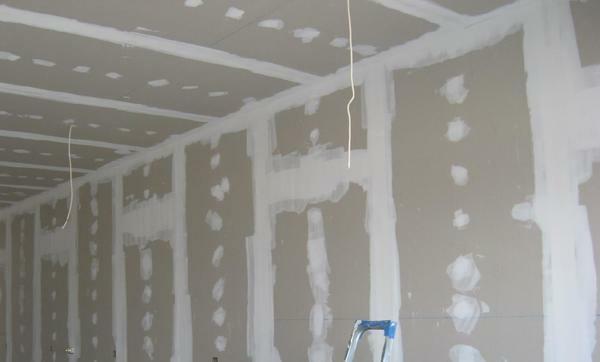 Wallpaper will serve you for a couple of years longer if properly prepare the wall before their glue
Wallpaper will serve you for a couple of years longer if properly prepare the wall before their glue
To date, wallpaper has a low quality, and thus quickly lose its original attractiveness. Wallpapers that are expensive, if properly glued, will serve for at least 10 years, until they get bored.
What to do with very curved walls
Very often it happens that the walls in the room are very crooked. Because of this, all the finishing materials will go badly, and subsequently there will be noticeable defects. In such cases, the walls are prepared in the same way as usual, but only the stages of work are performed more carefully.
What you need to pay special attention to:
- Choose wallpaper you need vinyl or from non-woven. Due to the fact that they are dense and multilayered, they can completely or partially hide some defects.
- For wallpaper, you need to buy only special glue, which should be applied to both the wallpaper and the walls.
If the room also has an uneven ceiling, do not panic. To some extent, hide defects and irregularities using a ceiling skirting board.
Preparing walls for wallpaper with your own hands( video)
Before preparing the walls for wallpapering, you must carefully disassemble the order of work before you begin to implement them. This process seems easy only at first glance. If you do not follow all these simple rules for preparing the walls for wallpapering, the work will be done in vain and later you will have to repeat everything again.


